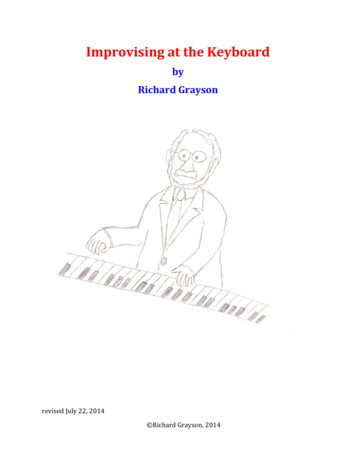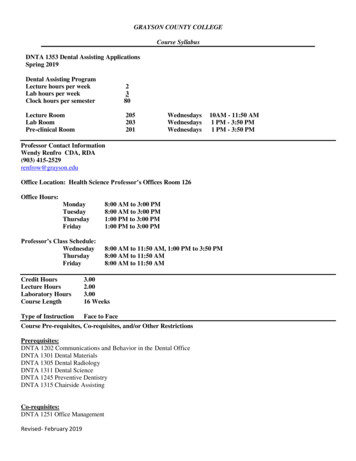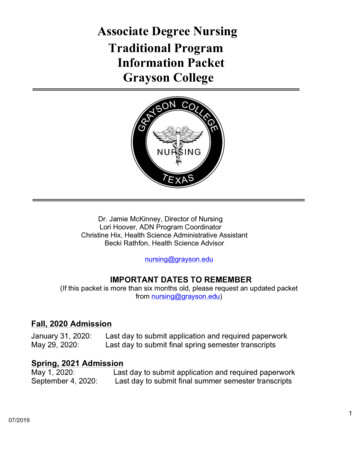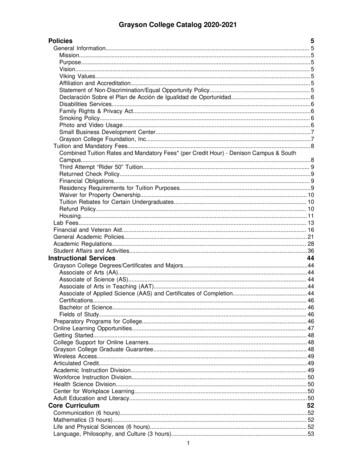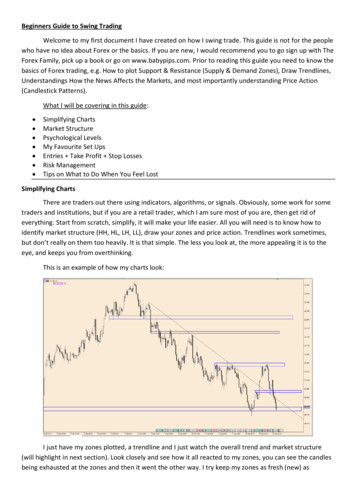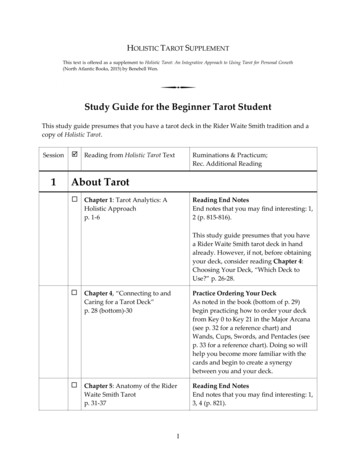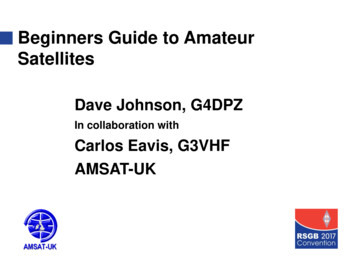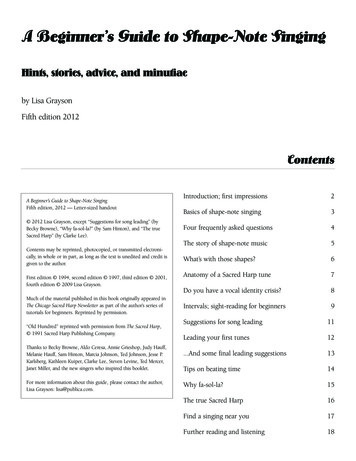
Transcription
A Beginner’s Guide to Shape-Note SingingHints, stories, advice, and minutiaeby Lisa GraysonFifth edition 2012ContentsA Beginner’s Guide to Shape-Note SingingFifth edition, 2012 — Letter-sized handout 2012 Lisa Grayson, except “Suggestions for song leading” (byBecky Browne), “Why fa-sol-la?” (by Sam Hinton), and “The trueSacred Harp” (by Clarke Lee).Contents may be reprinted, photocopied, or transmitted electronically, in whole or in part, as long as the text is unedited and credit isgiven to the author.First edition 1994, second edition 1997, third edition 2001,fourth edition 2009 Lisa Grayson.Much of the material published in this book originally appeared inThe Chicago Sacred Harp Newsletter as part of the author’s series oftutorials for beginners. Reprinted by permission.“Old Hundred” reprinted with permission from The Sacred Harp, 1991 Sacred Harp Publishing Company.Thanks to Becky Browne, Aldo Ceresa, Annie Grieshop, Judy Hauff,Melanie Hauff, Sam Hinton, Marcia Johnson, Ted Johnson, Jesse P.Karlsberg, Kathleen Kuiper, Clarke Lee, Steven Levine, Ted Mercer,Janet Miller, and the new singers who inspired this booklet.For more information about this guide, please contact the author,Lisa Grayson: lisa@publica.com.Introduction; first impressions2Basics of shape-note singing3Four frequently asked questions4The story of shape-note music5What’s with those shapes?6Anatomy of a Sacred Harp tune7Do you have a vocal identity crisis?8Intervals; sight-reading for beginners9Suggestions for song leading11Leading your first tunes12.And some final leading suggestions13Tips on beating time14Why fa-sol-la?15The true Sacred Harp16Find a singing near you17Further reading and listening18
IntroductionIf you respond to the pulsing beat, the rich harmonies, thepowerful poetry, or the deep spiritual current of a SacredHarp singing, you are joining generations of Americanswho found sustenance and joy in this musical tradition.This booklet was compiled with an eye toward introducingyou to the basics of the music, so that you can fully enjoyand participate in singing.Like many brand-new singers, your author fell in love withSacred Harp music from the very first song I heard at theUniversity of Chicago in February 1990, even though mynose was buried in the tunebook, and my mind in confusion, all afternoon. I plowed on for months, often clueless,for I was moved by the sound in a way I am still unable toarticulate fully. Most of the entries in this booklet are theresult of my continuing Sacred Harp self-education, andshould be treated as such: a collection of tips and anecdotes by an amateur with no formal musical training.Please write to me with any comments, and Sacred Harpquestions that remain unanswered, so that I can addressthem in future editions. Meanwhile, realize that you haveentered on a marvelous musical journey that will bringyou into the company of some of the finest people anywhere—Sacred Harp singers.Abraham Lincoln, shape-note singer?Carl Sandburg wrote in The American Songbag: “A famousoblong songbook of the pioneer days in the middle west wasthe Missouri Harmony. Young Abraham Lincoln and hissweetheart Ann Rutledge sang from this book in theRutledge tavern in New Salem, Illinois, according to old settlers there.” Miss Rutledge’s sister recalled,* “They used tosing together. There was one song I didn’t like to hear, andhe would sing it to tease me. He would tip back his chairand roar it out at the top of his voice, over and over again,just for fun.”The song is as follows: “When in death I shall calmlyrecline/ O, bear my heart to my mistress dear; / Tell her itlived on smiles and wine/ Of brightest hue while it lingeredhere; /Bid her not shed one tear of sorrow/ To sully a heartso brilliant and bright, /But healing drops of the red grapeborrow/To bathe the relic from morn to night.”*J.E. Gallagher, Best Lincoln Stories, Tersely Told, 1898.A few words about first impressionsWhere’s the audience?We don’t perform; we sing as an end in itself. Anyone iswelcome to just sit and listen, but will be encouraged toborrow a tunebook and sing along. We have no auditions,no rehearsals — if a song doesn’t sound quite right, weshrug it off and move onto the next one. All are welcometo join in.Why don’t you applaud?Traditional singers regard applause during the singing as ifit were applause during a worship service. We usuallyreserve applause for children and brand-new leaders. Evensingers who do not consider the Sacred Harp experience tobe a worship service acknowledge that we aren’t performing, so there’s nothing, and no one, to commend. We won’tshush you if you applaud, but please realize it’s not part ofour tradition!“the coffin, earth, and winding sheet,” as the otherwisesprightly tune “Morning Sun” (page 436) puts it. A majority of the texts are hymn or camp meeting songs, religiousin nature; after all, shape-note music took root as a way toteach unlettered Americans how to worship through song.Some people are initially put off by many of the texts, particularly those who prefer a spiritual practice that’s allsweetness and froth. Please know that some of the mostenthusiastic Sacred Harp singers—including a large percentage of people at any singing in the North—do notsubscribe to the same religious beliefs as the poets whowrote the texts, yet still appreciate their often austere andhaunting beauty.What’s with the gloom and doom?We can’t deny it: Many songs in The Sacred Harp tell ofIntroduction2
Basics of shape-note singingShape notesFa, sol, la, mi Ñ the four basic notes in our shape-note system.The music we sing is from The Sacred Harp, a hymnal originally published 150 years ago in a tradition older still. Itis passionate, spirited music that harks back to the dayswhen church music was intended to be sung by the congregation rather than the choir. Any type, quality, andrange of voice should find a comfortable and importantplace within its harmonies. The “sacred harp” is thehuman voice!Where should I sit?Sacred Harp music is divided into four parts: treble, alto,tenor (or lead), and bass. Depending on inclinations oftemperament, timbre, or necessity, women and men double on both the treble and tenor parts, with women usuallysinging an octave above the men.Men with “tenor” voices in standard choral music willprobably be most comfortable singing tenor or treble; baritones may like tenor or bass; basses—well, no problem.Women with high voices may like the tenor or treble parts(in high register); altos might try that part, althoughwomen with a strong low register could also sing tenor ortreble in the men’s range.The music in The Sacred Harp is written in standard notation, except that the notes appear in four different shapes(see illustration); therefore the music is also called “shapenote.” Itinerant early American tunesmiths and singingmasters used this four-note system to teach sight readingto people without musical training. Most of us first learneda seven-note “solfege” system: do-re-mi-fa-sol-la-ti-do. TheSacred Harp uses the old four-note English system: fa-solla-fa-sol-la-mi-fa.With our shape-note system, there’s no need to worryabout different keys. The shapes ingeniously indicatewhere the different pitches are. The interval between, say,any fa and the la above it is always the same.Before singing the words to a Sacred Harp tune, we “singthe notes” by singing the syllables of the shapes to try tolearn our parts before tackling the words. People who hearSacred Harp music for the first time are often baffled whenthe entire room breaks out into what sounds like gibberish. New singers may be daunted by the shapes, especiallyon fast songs. Just remember, the person who now confidently sings mile-a-minute fa-sol-las had to learn themslowly, too. So jump in and sing “la” if you aren’t sure;you’ll be right 25% of the time! And the shapes thatseemed so strange at first will soon help you to sight sing.Some sections above adapted from Steven Levine’s “A Sacred HarpGuide for Newcomers,” in Prairie Harmony (Minnesota Sacred Harpnewsletter), Oct.1990.When in doubt—sing tenor. That’s where the melody is.But feel free to move around to different parts to see whatfeels comfortable to you.The hollow square and song leadingSacred Harp music is traditionally sung in a “hollowsquare” with each voice part taking one of the four sidesand facing the center. The song leader stands in the center,beating out the rhythm and delighting in the surge of voices and blending of sound from all four sides. (Newcomersare often encouraged to “stand in the middle” to experience the full power and exaltation of the music.) Songleaders face the tenor section to help carry the melody ofthe song.Sacred Harp leading is egalitarian. Everyone has a chanceto lead the song of his or her choice. Newcomers are welcome, and encouraged, to lead. Don’t worry—just face thetenor section and follow the hand motions of the front rowof tenors and you will be fine.fasollafasollamifaC major scale, written to show how the shapes appear in whole, half,quarter, and eighth notes.Intervals between shapes are the same in any key! Here, fa-las in Amajor (treble clef, left) and G minor (bass clef, right). Note triangle faand square la.Basics of shape-note singing3
Four frequently asked questions about Sacred HarpWhy is everyone singing at the top of their lungs?Sure enough, the symbols used to indicate loudness orsoftness in regular music are conspicuously absent in ourshape-note book. And the more experienced singers dosing at a consistent fortissimo that can be alarming to people hearing the music for the first time. Singers mayexchange knowing looks as a newcomer accidentallycaught between two legendarily loud voices beats a quickretreat to a quieter spot. Basically, in Sacred Harp singing,loud is good, and louder is better. And so you might hearsingers say “good alto!” after being blasted out of theirchairs by the low-timbred ladies.This music is for singers, not for listeners. And for amateur, untrained voices at that. We set our chairs in a hollowsquare; there’s no audience at our singings. We don’trehearse, or perform; we sing as an end in itself. And loudsinging provides more catharsis, more instant gratification,more visceral pleasure, than controlled singing. (No wonder many early church leaders considered it sinful, despitethe pious poetry of the songs.)By the way, 18th-century composer William Billings himself was a practitioner of loud singing. Billings even suggested:“.if there happens to be a Number of greater Voices in theConcert than your own, they will swallow you up; therefore insuch a case, I would recommend to you the resolution (tho’ notthe impudence) of a discarded Actor, who after he had beentwice hissed off the Stage, mounted again, and with greatAssurance he thundered out these words ‘I will be heard.’ ”Keep Billings’s words in mind the next time you find yourears ringing at a Sacred Harp singing.She will bring her arm down for the first two beats of ameasure, then up for the last two beats. In 3/4 (waltz)time, the arm moves and stops halfway down on one,down further on two, and up on three. In all tempos, thehand is at its highest point at the top of a measure, and“jumps over” the measure bar.Try beating time with the other singers; watch the leaderor the front row of tenors to match your pace. It takespractice, but you’ll find it helps you follow the music.I noticed that the most confident, loud, experiencedsingers tend to sit in the front row at big conventions. But I wish I could sit next to someone whoknows what he’s doing! Why don’t the experiencedsingers sit in the back and help the rest of us?Miss Grace Notes, etiquette expert, has an answer to thisthorny question. “The front bench of any part,” she wrotein The Chicago Sacred Harp Newsletter, “can help the new[song leader] out, helps keep the beat for the entire class,sings out sure and strong, and generally helps to hold asinging to-gether, to make it a memorable experience.theywork hard keying songs, beating time, and keeping thingson track.”At large singings, where there are a number of strongsingers on each part, the more experienced singers oftenrotate time on the front bench as a courtesy. They may onoccasion invite new singers to sit with them. And of coursesome strong singers will wind up in the back rows becausethey come in late, don’t feel like working so hard, or wantto help out new singers. But realize that strong voices areneeded in the front rows, even at a small singing. The easeof shape-note singing allows inexperienced singers to get byon their own without relying on a strong voice nearby.Why are people moving their arms up and down?This is one of the most baffling aspects of Sacred Harpsinging for newcomers. The hand and arm motions are atraditional way of keeping time. When a person stands inthe middle of the square to lead a song, he moves his armto indicate the tempo to the rest of the class; other singersjoin in these peculiar-looking movements because it helpsthem keep the rhythm—and it can be fun. [See p. 14.]Here’s how it works. As alto Marcia Johnson says, you caneither march to a song or waltz to it. If a song is written in4/4 (march) time, the leader beats out one-two-three-four.Help! I opened the book to the page the leadercalled out, and I have no idea what’s going on!Don’t despair—most people have this reaction when theygo to a singing the first time. Remember the melody (tenorpart) is the third staff down. Sit with the tenors and try tofollow along. At a break in the singing, find someone whoseems to know what he or she is doing and ask questions!We’ll be happy to help you. At home, sing along withSacred Harp tapes. Do persevere: shape notes have taughtgenerations of Americans to sing without formal training.Four frequently asked questions4
The story of shape-note musicFrom New England to the West and South, nearly everyone in early America who learned to read vocal music didso using a system of shaped notes—different shapes for thenotes of the scale—that has come to be known as “fasola”music. Our singings today reflect a rich tradition.BeginningsThe English used a four-note system centuries ago; a villain in Shakespeare’s 1605 King Lear sings “fa, sol, la, mi.”But they did not use noteheads of different shapes. A 1721Boston music book placed the first letter of the four syllables on the music staff and used dots to indicate duration.But not until around 1800 did William Little and WilliamSmith of Philadelphia introduce the four-shape system as asight-reading aid in The Easy Instructor. It worked so well,others soon adopted it.Title page, The Easy Instructor, 1802, Little and Smith. ÒPublishedfor the use of singing Societies in general, but more particularly forthose who have not the advantage of an Instructor.ÓWhile the four-note system is the original and oldestshape-note system, seven-shape scales (using do-re-mi)were used in late-19th-century gospel music. The sevenshape system once eclipsed the four-note version, but it isour fa-sol-la that prevails today.“Why should the devil have all the good music?”Many shape-note tunes are old folk melodies that madethe passage from England, Ireland, Scotland, or Wales.Catchy songs were adapted by religious leaders and songmasters who asked “Why should the devil have all thegood music?” They set pious lyrics to sprightly secular folkmelodies and transposed pre-1800 revival songs to shapenotation.Familiar tunes, combined with the shaped notation for easeof reading, helped spread shape-note music in earlyAmerica. Vigorous song accompanied religious revivals, andtunes such as “Sweet Morning” rang out at camp meetings.Refuge in the SouthIn the early 1800s, ironically soon after the nation won itsindependence, this American folk music was slowly driven from its first home in New England by people whoconsidered it too raw and coarse, preferring the “refinement” of European music. But shape-note singing tookroot in the rural South and the lower Midwest, where nosuch snobbery prevailed; revivals helped spread and preserve the music.Singing schools; the preservation of traditionBefore the Civil War, shape-note music was an importantpart of the social and religious life of rural America. Shapenote singing schools, held by itinerant singing masters incabins, schools, and churches, taught thousands of familiesthe rudiments of music in energetic a cappella three- andfour-part harmony that delighted or dismayed all whoheard it. According to one historian, young students “alsoused the singing-school as a place where they could makenew friends, exchange notes, flirt, walk home togetherafter lessons, and in general, enjoy themselves.”After learning the basics of fasola, entire communitieswould gather for all-day singings. The largest of these frontier gatherings, which might last several days, were called“conventions.” By 1860, conventions sprouted in theSouth, and dozens of shape-note tunebooks were in print.As remarkable economic and cultural changes in bothNorth and South after the Civil War eroded much of ruralAmerican life, fasola declined to the point of being considered extinct. In 1935, however, scholar George PullenJackson revealed that thousands of traditional singers werestill flourishing in the southern mountains, holding singingschools, all-day singings, and conventions. They sang fromthe 1844 Sacred Harp.In recent years, fasola (now often called “Sacred Harpsinging” after the surviving tunebook) has enjoyed a revivalin its old territories, including New England and theMidwest. Participants sing the old way, facing each other ina hollow square, taking turns leading songs (anyone whowishes to lead may), and enjoying the fervent lyrics—mostly dating from the 18th century—set to primitive, powerfultunes using ancient scales, unusual voicings, and unexpected harmonies. Well-attended conventions are now heldannually in the South, New England, California, Chicago,Washington D.C., Minnesota, Ohio, Missouri, Texas, andelsewhere (and not just the United States) as 21st-centurysingers rediscover part of their musical heritage.The story of shape-note music5
What’s with those shapes?Major scale: fa sollafasol la mi fa“Help! What on earth are you singing?” We hear that pretty often when we “sing the notes” of our Sacred Harptunes. If you’re a new singer confused by the shapes—whether you read conventionally printed music or not—here are a few tips. Also, see “Basics for new singers,” and“Sight-reading for absolute beginners” in this guide.Why we use shape notesAround 1800, William Little and William Smith of Philadelphia devised a system to help people learn to readmusic. They figured it was easier to teach singers to understand a single musical key than to insist on their learningthe intricacies of key signatures. Regardless of the key asong is written in, the intervals between shapes are thesame.What happened to do-re-mi?You don’t have to be a Sound of Music fan to wonder whywe use just four shapes instead of seven. Why not, say, alittle deer for do, a sun for re. Actually, some Americantunebooks were written in seven shapes; The New Harp ofColumbia, for example, is still used by singers in northeastTennessee. But the four-shape system was easier for mostpeople, and it’s more widely used than the seven-shapemethod today. The four syllables fa, sol, la, mi date back tothe 10th century. (See “Why fa-sol-la?” on page 25.)So what do I do if I can’t sing the shapes?To start out with, just sing “la” or even a grunting “uh”when everyone is singing the shapes. Then try masteringone shape at a time. For example, try singing “fa” on eachtriangular note, and ”la” or the unintelligible sound of yourchoice on the other notes. Start with the slow songs, whenyou can really grab on to that fa for a long time; don’tworry about making mistakes. Then, when you feel moreconfident, choose a second shape and do the same thing,until you’ve made it through all four shapes. Practicesinging along with tapes. Don’t worry about the fast songs;they’ll come to you in time.Minor scale: lamifa sollafa sol laI can’t read regular music. Am I hopeless?Far from it. In fact, even though the shapes seem weird toyou now, you’ll probably find shape-note music much easier to read than conventional notation—no key signaturesto worry about. (Your author here had faked her waythrough “round-note” sight-reading for twenty years beforecatching on with the shape-note method.)If you have never even tried to read music before, you’rein luck: the shape-note method was designed for peoplejust like you. Generations of Americans, many of them illiterate, learned to sing with shape-note books. Hang in there!How long until I know what I’m doing?Well, that depends. The more you sing, the faster you’llpick up the shapes. And some vocal parts tend to haveeasier patterns; basses will learn the tonic notes, fa inmajor-key songs and la in minor ones, in no time; altoswill soon start to recognize the sequence fa-sol-la in majorkeys. Be patient with yourself; it may take several monthsbefore you feel comfortable singing the notes on slowersongs. But before you know it, you’ll hear someone singout the pitch, and you’ll instantly know what your note is.Then, you’ll encounter a new song and—surprise!—theshapes will guide you to sight-read the entire tune.Postscript for altos only: About the bass clefWhen the alto part is written in the bass clef (), sing itan octave above where it’s written. The only reason someof the songs use the bass clef for the alto is to avoid theuse of ledger lines (above or below the five-line staff) tokeep the printed page as uncluttered as possible. You’llfind the shapes a tremendous help if you’re accustomed toreading only treble-clef parts.What’s with those shapes?6
Anatomy of a Sacred Harp tune¹½¶º¼· »¾¿111. Name of tune (Old Hundred) followed by the song’smeter. L.M. stands for long meter; four lines, each with fouriambic feet. Thus, the first line,O come loud anthems let us sing(stressed syllables in italic)The stressed syllables correspond to the accented beats—inthis case, the first beat of each measure.6. Composer and, when known, year the tune was written. Many tunes in The Sacred Harp are old folk melodies,unattributed and undatable.2. Page number.3. The Sacred Harp includes a relevant Bible verse foreach tune, selected by the composer when possible.4. Key in which the song is written. This bears little relation to the key in which the song is actually sung. SacredHarp singers traditionally key songs without a pitch pipe; asinger with a good ear will sound the notes of the firstchord, trying to find a vocal range to make the song bothinteresting and comfortable. You can find the tonic,or keynote, in the last note of the bass part (la minor, fa major).Old Hundred is written in A major. The shape-notemajor scale isfasollafasollamifaFor those who follow conventional music notation, the Amajor scale isAdo5. Poet(s) and year the words were written. Tunesmithsusually borrowed existing verses. They did (and do) notcollaborate with “lyricists” à la Rodgers and Hammerstein.Many of the songs in The Sacred Harp share the samewords, borrowed by different composers long before thedays of copyright.BreC# D Emi fa solF# G# Ala ti doThe treble singers (top staff), tenor (third) and bass (bottom) all start out on the triangular fa (A); the altos (secondstaff) begin on the round sol note (E). The pitch personwill sing out fa and sol to give the starting notes.7. Time signature. 2/2 means the song has two beats to ameasure; a half note gets one beat. The song leader willbring his hand down on one, up on two.8. Treble staff. A high harmony part, sung by both menwith high tenor ranges and women with soprano voices.9. Alto staff. Sung by women with low voices (and, rarely,men). Some of the older tunes omit the alto part; the altosusually sing the bass part in these songs.10. Tenor, or lead, staff. In Sacred Harp, the tenors singthe melody. (You may know Old Hundred’s melody as thedoxology, “Praise God from whom all blessings flow.”)Both men and women sing tenor. This includes men whoare true tenors, sopranos who sing the melody an octaveabove the men, and women with lower voices who sing inlow register (or jump back to a higher range when it suitsthem). Song leaders face the tenor section and traditionallysing the tenor part when they lead, no matter what partthey usually sing.11. Bass staff. For low male voices. Written in bass clef.Anatomy of a Sacred Harp tune7
Are you stuck with the same part in Sacred Harp that you sing in other music?Do you have no clue where you belong? Is your part too high, too low, too dull? In other words. . .Do you have a vocal identity crisis?This is for singers who come to Sacred Harp with experience singing in choirs, choruses, or other groups, even if itwas back when the mighty stegosaurus ruled the plains. Ifyou were an alto back then, maybe you figure you shouldsing alto in Sacred Harp; other parts likewise. But youmight actually be singing the wrong part for your voiceand pleasure.the alto section because they always sang alto. Some choraldirectors (especially of the high-school variety) banish toalto purgatory any female who can’t do a passable RenéeFleming imitation on a high A. You may not be a truealto—you might just have a limited vocal range. Even ifnot, consider the peculiarities of altodom in Sacred Harpbefore you dismiss the possibility of singing tenor.Maybe if we called the tenor part “lead,” as manySoutherners do, or even “the melody,” people wouldn’tfigure they needed a set of pipes like Pavarotti to sing it—or, for that matter, a beard. Women can sing it in theirhigh or low register, or jump from high to low and backagain like certain people. And men—just remember, wesing most tunes at least a step below where they’re written.Sure, you see some guys turning purple and throwing theirheads way back on the higher tenor notes, but think aboutit: if you look and sound like a walrus in distress on thelow notes of the bass part, you would probably have a better time singing tenor, and your fellow singers will thankyou for it.The Sacred Harp alto sound is completely different fromthat of—well, any music this alto has ever sung or heard.First, the good news: we rarely go as high as most choralalto parts. Now the bad news: our part is often dull (butyou probably knew that already) and you must leave yourMarlene Dietrich impersonation at home. Sacred Harpaltos do not go for thrilling, sultry, rounded low tones. It’smore like grinding, wailing, ear-shattering low tones. Oneof the peculiarities of Sacred Harp is its characteristicallypiercing chest-voice alto (diplomatically called “having anedge to it”); if you sound sultry singing “Stratfield,” honey,you are definitely doing something wrong.We Yankees have a lot of fake basses who rightly belong inthe tenor section. You guys would have more fun overthere (the part is more interesting, after all). Somehow,though, a few Northerners have developed this macho bassmystique that the older traditional Southern singers thankfully are lacking. Now, if you are a true bass, I say Godbless you and come sit near the altos where I can hear you.If you’re really a baritone, try singing tenor and see if youlike it. And if you are on that bench because you think it’smore manly than singing one of the higher parts, whereyour voice naturally falls—well, get over it. Be your trueself even if it takes you over to the treble section, whereyou can really show vocal courage.You sopranos may have gravitated toward the treble section when you heard someone mention “high harmony,” orwhen you heard a beckoning shriek from a certain side ofthe room. But have you tried singing the tenor part in yourusual high register? And guys, maybe you sang tenor inyour choral days, or you sing it in a choir now—but ifyou’re a First Tenor, you should check out the treble partsometime. And if you’re shooting blanks every time thenotes go above the staff, it’s off to the bass section with you.I’d like to address the altos for a moment, for at anysinging you can see plenty of newcomers asking to sit inThe most important thing to remember is: Sacred Harpshould be fun. If you’re uncomfortable singing a part, orbored, or just curious, move around. You can always goback! If you feel that moving to another section would besilly since you’ve just started to learn your part to some ofthe songs—well, don’t do anything traumatic, but realizethat you’re really not doing yourself a favor by staying put.If you know you’re in the right part, great. Even so, try sitting in the tenor section sometime (if you’re usually on oneof the other parts) just so you can hear the melodies andhow the other parts, including yours, fit them. Then youcan slink back to your usual section, wiser.Why do Northern singers travel South?Because that’s where the best pecan pie is. It’s also theheart of our musical tradition. We want to sing withpeople who have attended singings all their lives, whokeep the tunes in their souls in a way those of us whodiscover the music in adulthood cannot. Sacred Harpis a true American folk art, and we have much to learnfrom the Southern singers—black and white—thewonderful folk who have kept it alive.Do you have a vocal identity crisis?8
Intervals: The steps between notesThe word interval comes from the Latin intervallus: literally,the space between ramparts. In modern English, intervalhas come to mean the space between any two things,whether the space refers to distance, time, or sound.The music in The Sacred Harp is written in standardnotation, except that the notes appear in four differentshapes (see illustration) — so the music is also called“shape note.” Itinerant early American tunesmiths andsinging masters used this four-note system to teach sightreading to people without musical training.Most of us
Guide for Newcomers,” in Prairie Harmony (Minnesota Sacred Harp newsletter), Oct.1990. Basics of shape-note singing 3 Basics of shape-note singing Fa, sol, la, mi — the four basic notes in our shape-note system. C major scale, written to show how the
